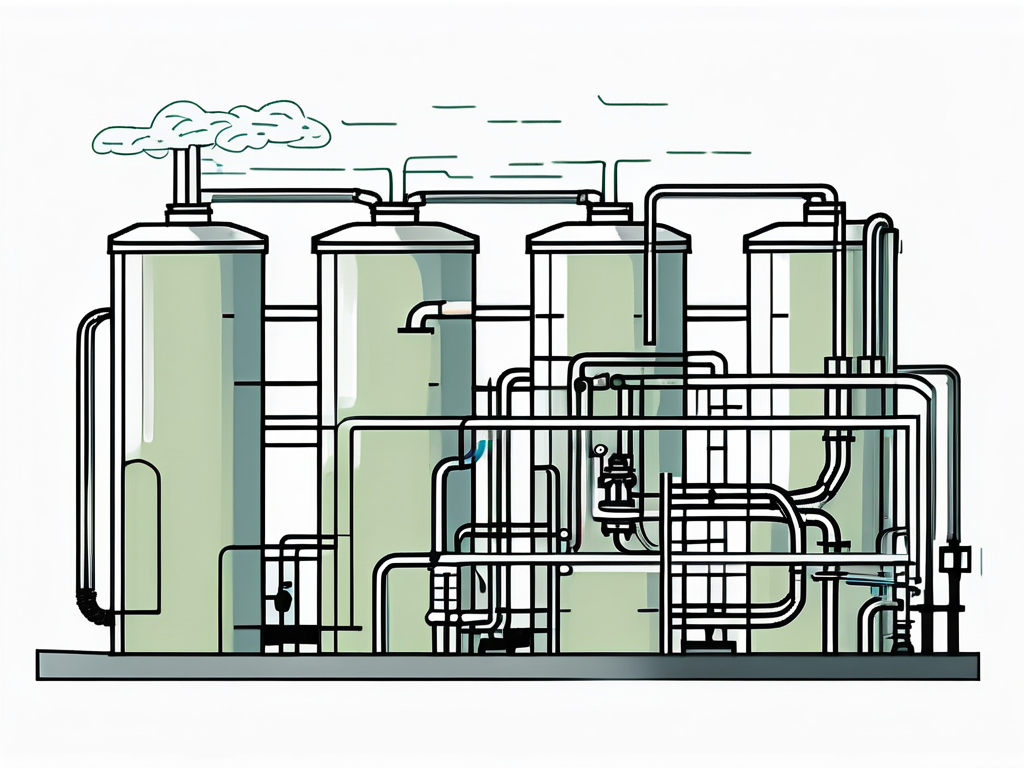
Xenobiotics: Wastewater Treatment Explained
Xenobiotics are synthetic, man-made compounds that are not naturally occurring in the environment. They are often found in wastewater and can pose significant challenges to treatment processes due to their complex structures and resistance to degradation. This article provides a comprehensive glossary of terms related to the treatment of xenobiotics in wastewater, aiming to provide a thorough understanding of the topic.
Understanding the terminology related to xenobiotics and wastewater treatment is crucial for professionals in the field, as well as for anyone interested in environmental science, chemistry, or public health. This glossary will delve into the various processes, techniques, and challenges associated with xenobiotic wastewater treatment.
Definition of Xenobiotics
Xenobiotics are chemical substances that are not naturally produced or expected to be present within an organism or in the environment. They are often synthetic compounds, including pharmaceuticals, personal care products, pesticides, and industrial chemicals. Because they are not naturally occurring, xenobiotics can be difficult for organisms and environmental processes to break down, leading to their accumulation in the environment.
Many xenobiotics are resistant to degradation due to their complex molecular structures. This resistance can lead to bioaccumulation, where the substances build up in organisms over time, potentially leading to harmful effects. Understanding the nature and behavior of xenobiotics is crucial for developing effective wastewater treatment strategies.
Types of Xenobiotics
There are many different types of xenobiotics, each with its own properties and challenges for wastewater treatment. Some common types include pharmaceuticals, personal care products, pesticides, and industrial chemicals. These substances can enter the environment through various routes, including direct discharge, runoff from agricultural fields, and disposal of unused products.
Pharmaceuticals, for example, can enter the environment through human excretion or improper disposal of unused medication. Personal care products, such as shampoos and soaps, can enter the environment through bathing or washing. Pesticides can enter the environment through runoff from agricultural fields, while industrial chemicals can be discharged directly into the environment during manufacturing processes.
Wastewater Treatment
Wastewater treatment is the process of removing contaminants from wastewater to make it safe for discharge into the environment or for reuse. The process typically involves physical, chemical, and biological processes to remove solids, organic matter, and pathogens. However, traditional wastewater treatment processes are often ineffective at removing xenobiotics, necessitating the development of advanced treatment techniques.
Wastewater treatment is a complex process that requires a deep understanding of the properties of the contaminants to be removed, as well as the physical, chemical, and biological processes involved in their removal. This glossary will delve into the various stages of wastewater treatment and the specific challenges posed by xenobiotics.
Primary Treatment
Primary treatment is the first stage of wastewater treatment and involves the removal of large solids and grit from the wastewater. This is typically achieved through screening and sedimentation processes. However, primary treatment is largely ineffective at removing xenobiotics, as these substances are often dissolved in the wastewater and cannot be removed through physical processes alone.
Despite its limitations, primary treatment is a crucial first step in the wastewater treatment process. It helps to protect the subsequent stages of treatment from damage or clogging by large solids, and it reduces the overall load of organic matter that needs to be treated in the later stages.
Secondary Treatment
Secondary treatment is the second stage of wastewater treatment and involves the biological degradation of organic matter. This is typically achieved through activated sludge processes or trickling filters. However, many xenobiotics are resistant to biological degradation, making secondary treatment ineffective at removing these substances.
Despite its limitations, secondary treatment is a crucial step in the wastewater treatment process. It significantly reduces the load of organic matter in the wastewater, helping to prevent oxygen depletion in the receiving water bodies. However, the resistance of xenobiotics to biological degradation highlights the need for advanced treatment techniques.
Advanced Wastewater Treatment Techniques
Advanced wastewater treatment techniques are designed to remove contaminants that are resistant to traditional treatment processes, including xenobiotics. These techniques often involve physical or chemical processes, such as adsorption, oxidation, or membrane filtration.
Advanced treatment techniques can be highly effective at removing xenobiotics, but they also come with their own challenges. For example, they can be more energy-intensive and costly than traditional treatment processes, and they may produce waste products that require further treatment or disposal. Understanding the principles and challenges of these techniques is crucial for their successful implementation.
Adsorption
Adsorption is a physical process where contaminants are removed from wastewater by adhering to the surface of a solid material, known as an adsorbent. Activated carbon is a commonly used adsorbent due to its high surface area and affinity for organic compounds. Adsorption can be highly effective at removing xenobiotics, but the adsorbent material can become saturated over time and may need to be replaced or regenerated.
Despite these challenges, adsorption is a widely used advanced treatment technique due to its simplicity and effectiveness. It can be used as a standalone treatment process or in combination with other techniques to enhance the overall removal of xenobiotics.
Oxidation
Oxidation is a chemical process where contaminants are converted into less harmful substances through the addition of oxygen. This can be achieved through various methods, including ozonation, advanced oxidation processes, and photocatalysis. Oxidation can be highly effective at breaking down xenobiotics, but it can also produce harmful byproducts that require further treatment.
Despite these challenges, oxidation is a widely used advanced treatment technique due to its ability to break down a wide range of contaminants. It can be used as a standalone treatment process or in combination with other techniques to enhance the overall removal of xenobiotics.
Challenges in Xenobiotic Wastewater Treatment
Treating wastewater contaminated with xenobiotics poses several challenges. These substances are often resistant to traditional treatment processes, necessitating the use of advanced techniques. However, these techniques can be more energy-intensive and costly than traditional processes, and they may produce waste products that require further treatment or disposal.

Furthermore, the wide variety of xenobiotics and their complex structures make it difficult to develop a one-size-fits-all treatment solution. Each type of xenobiotic may require a different treatment approach, and the effectiveness of the treatment can be influenced by a variety of factors, including the concentration of the xenobiotics, the properties of the wastewater, and the specific treatment techniques used.
Resistance to Traditional Treatment Processes
Many xenobiotics are resistant to traditional wastewater treatment processes. They are often not effectively removed during primary or secondary treatment, leading to their discharge into the environment. This resistance is largely due to their complex molecular structures, which make them difficult for organisms and environmental processes to break down.
This resistance poses a significant challenge for wastewater treatment, as it necessitates the use of advanced treatment techniques. These techniques can be more energy-intensive and costly than traditional processes, and they may produce waste products that require further treatment or disposal.
Variety and Complexity of Xenobiotics
The wide variety of xenobiotics and their complex structures pose a significant challenge for wastewater treatment. Each type of xenobiotic has its own properties and behavior in the environment, making it difficult to develop a one-size-fits-all treatment solution. Furthermore, the presence of multiple types of xenobiotics in the same wastewater can complicate the treatment process.
Despite these challenges, understanding the properties and behavior of different types of xenobiotics is crucial for developing effective treatment strategies. This requires a deep understanding of the chemistry of these substances, as well as the physical, chemical, and biological processes involved in their removal.
Future Directions in Xenobiotic Wastewater Treatment
Despite the challenges, there is ongoing research and development in the field of xenobiotic wastewater treatment. Scientists and engineers are continually seeking to develop more efficient and cost-effective treatment techniques, as well as to better understand the behavior of xenobiotics in the environment.
Some promising areas of research include the development of new adsorbent materials, the optimization of oxidation processes, and the use of biological processes to break down xenobiotics. There is also growing interest in the recovery of valuable resources from wastewater, such as nutrients and energy, which could help to offset the costs of treatment.
New Adsorbent Materials
One area of research in xenobiotic wastewater treatment is the development of new adsorbent materials. These materials aim to provide a higher surface area and greater affinity for xenobiotics, allowing for more efficient removal. Some promising materials include biochar, graphene, and metal-organic frameworks.
Despite the potential of these new materials, there are still many challenges to overcome. For example, the production of these materials can be costly and energy-intensive, and the materials themselves may require further treatment or disposal after use. However, the development of new adsorbent materials holds promise for improving the efficiency and cost-effectiveness of xenobiotic wastewater treatment.
Optimization of Oxidation Processes
Another area of research in xenobiotic wastewater treatment is the optimization of oxidation processes. This involves improving the efficiency of existing processes, such as ozonation and advanced oxidation processes, as well as developing new processes. Some promising areas of research include the use of catalysts to enhance the oxidation process, and the combination of oxidation with other treatment techniques.
Despite the potential of these optimization strategies, there are still many challenges to overcome. For example, oxidation processes can be energy-intensive, and they can produce harmful byproducts that require further treatment. However, the optimization of oxidation processes holds promise for improving the efficiency and effectiveness of xenobiotic wastewater treatment.
Biological Processes
A third area of research in xenobiotic wastewater treatment is the use of biological processes to break down xenobiotics. This involves harnessing the natural abilities of microorganisms to degrade organic compounds. Some promising areas of research include the use of genetically engineered microorganisms, and the development of bioaugmentation and biostimulation techniques.
Despite the potential of these biological processes, there are still many challenges to overcome. For example, the effectiveness of these processes can be influenced by a variety of factors, including the properties of the wastewater and the specific types of xenobiotics present. However, the use of biological processes holds promise for improving the sustainability and effectiveness of xenobiotic wastewater treatment.
Conclusion
Understanding the terminology related to xenobiotics and wastewater treatment is crucial for professionals in the field, as well as for anyone interested in environmental science, chemistry, or public health. This glossary has provided a comprehensive overview of the various processes, techniques, and challenges associated with xenobiotic wastewater treatment.

Despite the challenges, there is ongoing research and development in the field of xenobiotic wastewater treatment. With continued efforts, it is hoped that more efficient and cost-effective treatment techniques can be developed, helping to protect our water resources and the environment for future generations.



